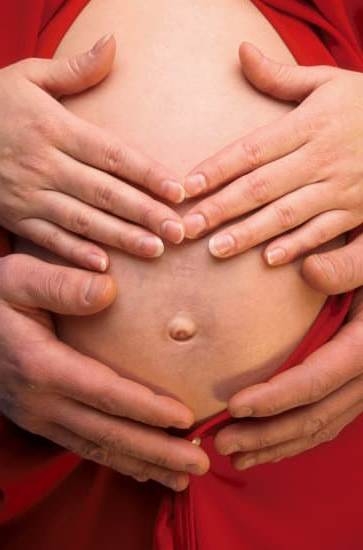Spotting in early pregnancy can be a cause of concern for many expectant mothers. It is natural to worry about any signs of bleeding during this crucial time, but understanding what spotting looks like and when it may occur can alleviate some anxieties. In this section, we will define what spotting is in the context of pregnancy and delve into the common concerns and anxieties surrounding spotting in early pregnancy.
When it comes to early pregnancy, spotting refers to light bleeding that occurs outside of a woman’s regular menstrual cycle. This can include slight bleeding or pink, red, or brown discharge. Many women worry that any form of bleeding indicates a problem with the pregnancy, leading to stress and anxiety. Understanding the causes and characteristics of spotting in early pregnancy can offer reassurance and peace of mind to expectant mothers.
One common concern about spotting in early pregnancy is whether it signifies a potential miscarriage. Other worries include the fear of complications or underlying health issues. By addressing these concerns and providing valuable information on what spotting looks like and why it occurs, we aim to guide expectant mothers through this common yet often stressful experience. Understanding the intricacies of early pregnancy spotting is crucial for maintaining emotional well-being during this delicate stage of life.
Causes of Spotting in Early Pregnancy
Spotting in early pregnancy can be a source of great anxiety for many women. It is important to understand the various causes of spotting in order to alleviate some of that worry. Here are some common reasons for spotting in early pregnancy:
- Implantation bleeding: This occurs when the fertilized egg attaches itself to the wall of the uterus, usually around 6-12 days after conception. It may cause light spotting and is considered a normal part of the implantation process.
- Hormonal changes: Pregnancy causes significant hormonal fluctuations, which can lead to changes in cervical mucus and slight bleeding or spotting.
- Cervical irritation: Increased blood flow to the cervix during early pregnancy can make it more sensitive, causing it to bleed easily during intercourse or a pelvic exam.
Understanding these common causes can help alleviate some worries about spotting in early pregnancy. It is important to keep in mind that while spotting can be a normal part of early pregnancy, it is always best to consult with a healthcare provider if there are any concerns about bleeding.
As for what does spotting look like in early pregnancy, it can vary from woman to woman. The characteristics of this type of bleeding can include:
- Light pink or dark red in color
- Watery or mucousy consistency
- May be intermittent and not as heavy as a regular period
These are general characteristics of spotting, but it’s important to remember that every woman’s experience may differ. If you are unsure about any bleeding during your pregnancy, it is best to seek advice from a healthcare professional.
Characteristics of Spotting
Spotting in early pregnancy can be a cause of concern for many women, as they may wonder “what does spotting look like in early pregnancy?” Understanding the characteristics of spotting is important for expectant mothers to distinguish between normal changes and potential signs of a problem.
Appearance, Color, and Consistency
Spotting in early pregnancy typically appears as light bleeding or pink or brown discharge. It is often much lighter than a regular menstrual period, and the consistency may vary from being watery to slightly thick. The color may change over time, starting off pinkish and then turning to a darker brown color.
Examples and Descriptions
What does spotting look like in early pregnancy? It can resemble a few drops of blood on underwear or toilet paper after wiping. Some women describe it as similar to the discharge experienced at the beginning or end of their menstrual cycle. It is important to note that if the bleeding is heavy or accompanied by severe cramping, it may not be considered spotting and could indicate a more serious issue.
Seeking Medical Advice
If you are experiencing spotting in early pregnancy, it’s essential to consult with your healthcare provider. They can assess your individual situation and provide guidance on whether the symptoms are within normal range or require further investigation. Additionally, monitoring the characteristics of the spotting over time can help your healthcare provider make an accurate assessment.
When Does Spotting Occur
Spotting in early pregnancy can occur at various times and for different reasons. Understanding when to expect spotting can help alleviate some of the concerns and anxieties that come with this symptom.
Timing of Spotting
Spotting can occur at different points in early pregnancy, but it is most commonly experienced around the time of implantation, which typically happens 10-14 days after conception. This is when the fertilized egg attaches itself to the uterine lining, causing slight bleeding or spotting. Additionally, hormonal changes in the body during early pregnancy can also lead to spotting.
Frequency of Spotting
In most cases, spotting is minimal and may only last for a few hours to a couple of days. It is not uncommon for women to experience spotting around the time they would have had their menstrual period. However, frequent or heavy spotting should be discussed with a healthcare provider.
What Does Spotting Look Like?
The appearance of spotting in early pregnancy can vary from woman to woman. It is often lighter in color than regular menstrual bleeding and may appear as light pink or brown discharge. Some women may also experience slight cramping along with the spotting.
Understanding when to expect spotting and what it may look like can provide reassurance for expectant mothers experiencing this common occurrence in early pregnancy. However, any concerns about spotting should always be discussed with a healthcare provider to ensure the health and well-being of both mother and baby.
Distinguishing Between Spotting and Normal Menstrual Bleeding
Characteristics of spotting in early pregnancy can vary from person to person, but there are some general traits that may help distinguish it from normal menstrual bleeding. In most cases, early pregnancy spotting is lighter and more intermittent than a typical period.
The color of the blood may range from light pink to dark brown, and the consistency is often described as watery or mucous-like. Some women also report experiencing spotting alongside other symptoms such as cramping or mild discomfort.
It’s important to note that spotting in early pregnancy is typically much shorter in duration compared to a regular period. While menstruation can last anywhere from 3 to 7 days, spotting due to pregnancy usually only lasts for a couple of days at most. Additionally, the timing of spotting can also help differentiate it from normal bleeding – since it often occurs around the time of expected menstruation or a week after conception.
One way to distinguish between spotting and menstrual bleeding is by paying attention to any changes in flow and color. Spotting may start off light and become even lighter over time or stop altogether, whereas menstrual bleeding tends to start light, get heavier, then taper off. If anyone suspects they may be pregnant and experiences abnormal bleeding, it’s crucial to consult with a healthcare professional for further evaluation.
| Spotting Characteristics | Distinguishing Feature |
|---|---|
| Lighter and more intermittent | Compares with regular period flow |
| Color ranges from light pink to dark brown | Contrast with typical bright red menstrual blood |
| Shorter duration – usually lasting only a few days at most | Differentiate from standard menstrual cycle length |
Signs of Concern
Spotting in early pregnancy can be a cause for concern for many women, as it can be worrisome and anxiety-inducing. While spotting is often considered normal, there are certain signs that may indicate a more serious issue. It’s important to be aware of these signs and symptoms to ensure the health and safety of both the mother and the baby. Below are some red flags and symptoms that should prompt immediate medical attention:
- Heavy bleeding: If the spotting becomes heavier, akin to a regular period or even heavier, this could be a sign of something more serious.
- Severe abdominal pain: Intense pain in the abdomen, especially if it is persistent or accompanied by dizziness or fainting, should not be ignored.
- Passing blood clots: Passing blood clots is not typical with spotting in early pregnancy and could indicate a potential complication.
- Fever or chills: If you experience fever or chills along with spotting, it could be a sign of infection and should be addressed immediately.
If you experience any of these signs, it’s crucial to seek medical attention promptly. Contact your healthcare provider or go to the emergency room if necessary. It’s always better to err on the side of caution when it comes to the health of you and your baby.
Remember that every woman’s body is different, so what may be cause for concern for one person might not necessarily be the same for another. Trust your instincts and seek help if anything feels off or unusual. Your healthcare provider is there to support you through this journey and ensure that both you and your baby are healthy.
Coping With Spotting in Early Pregnancy
Spotting in early pregnancy can be a source of immense anxiety and concern for expectant mothers. It is important to remember that spotting, which is light vaginal bleeding, is relatively common in the early stages of pregnancy and does not always indicate a serious problem. However, coping with spotting can still be quite challenging for many women.
What does spotting look like in early pregnancy? The appearance of spotting can vary from person to person, but it usually manifests as light pink or brownish discharge. In some cases, it may resemble the discharge at the beginning or end of a menstrual period. The consistency of the discharge may also change, sometimes appearing watery and other times slightly thicker. Understanding these characteristics can help alleviate some of the worry associated with spotting.
One way to cope with spotting in early pregnancy is by seeking emotional support from loved ones or joining online communities where women share their experiences. Talking to others who have gone through similar experiences can provide reassurance and comfort during this stressful time. Additionally, practicing stress-reducing activities such as yoga, meditation, or gentle exercise may help manage anxiety related to spotting.
| Coping Mechanism | Description |
|---|---|
| Seeking Emotional Support | Communicating with loved ones or joining support groups |
| Stress-Reducing Activities | Engaging in relaxation techniques like yoga or meditation |
Conclusion
In conclusion, understanding what spotting looks like in early pregnancy is important for expectant mothers to alleviate concerns and anxiety. It is crucial to recognize that spotting can be a normal occurrence in early pregnancy, often attributed to implantation bleeding, hormonal changes, or cervical irritation. Educating oneself on the characteristics of spotting, such as its appearance, color, and consistency, can help distinguish it from regular menstrual bleeding.
It’s important to note that while spotting can be common in early pregnancy, there are instances where it may indicate a more serious concern. Knowing the signs of concern and when to seek medical attention is vital for the well-being of both the mother and the developing fetus. Seeking professional advice in cases of excessive or prolonged spotting, severe cramping, or other concerning symptoms is imperative.
Ultimately, coping with spotting in early pregnancy requires emotional support and reassurance. Expectant mothers should not hesitate to reach out for guidance and comfort from healthcare providers or support groups. By staying informed about what to expect and seeking appropriate care when needed, women can navigate through this aspect of early pregnancy with greater confidence and peace of mind.
Frequently Asked Questions
How Do You Know if You Are Pregnant Spotting?
You might be pregnant if you experience spotting, a light flow of blood that occurs when the fertilized egg implants in the uterus. It can be mistaken for a light period, but pregnancy tests can confirm.
What Does Early Pregnancy Discharge Look Like?
Early pregnancy discharge is typically milky white or clear and is known as leukorrhea. It’s normal and caused by increased estrogen levels and greater blood flow to the vaginal area.
Is Spotting at 5 Weeks Pregnant Normal?
Spotting at 5 weeks pregnant can be common and is usually harmless, often attributed to the embryo implanting into the uterine wall. However, it’s important to consult with your healthcare provider to rule out any potential issues.

Welcome to my fertility blog. This is a space where I will be sharing my experiences as I navigate through the world of fertility treatments, as well as provide information and resources about fertility and pregnancy.





